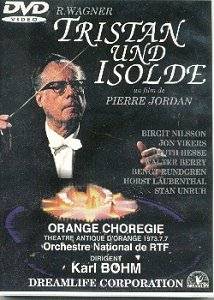Richard WAGNER (1813-1883) Tristan und Isolde (1856-1859) Isolde - Birgit Nilsson (sop) Tristan - Jon Vickers (ten) King Marke - Bengt Rundgren (bass) Kurwenal - Walter Berry (bar) Brangäne - Ruth Hesse (mez) Stanley Unruh - Melot (ten) Horst Laubenthal - Shepherd, Steersman & Sailor (ten) Recorded on 7 July 1973 at a public performance, Orange, France |
 |
Although I will discuss more fully the artistic qualities of this recording in my forthcoming survey of Tristan on record, it is such a performance of stature that an individual review is essential. It is only the second Tristan to appear on DVD - but is easily the finest. It also one of the greatest performances of the opera ever set down on either film or record.
Its greatness stems from the pairing of Nilsson and Vickers as the lovers and Böhm as the conductor. It is in turns a volatile, incandescent and passionate performance. It surges forward relentlessly - the theatricality perhaps more dramatically realised than in any other performance, including Böhm's 1966 Bayreuth Tristan with which it has much in common. Nilsson is the Isolde there as well - and the anger, frustration and meltingly intense singing of that performance are evident again in Orange, only perhaps even more so. Only two years earlier Nilsson and Vickers had sung their first Tristan und Isolde together at Buenos Aires under the lugubrious baton of Horst Stein - a recording that has recently been released on CD but which suffers markedly in comparison with this blistering performance. Vickers, who recorded the role for Karajan in 1972, is tremendous on all three recordings - tormented with pain in Act III, awe-inspiring in Act II. If the Karajan performance is perhaps a little glacial in its tone (not helped by a very forward brass balance) this Böhm recording seems almost fiery in its warmth. What both the Stein and the Böhm confirm, however, is that the urgency and unhinged passion of Vickers' Tristan is not unique to the Karajan set. Robin Holloway called it a 'tour de force' (although he admitted he never wanted to hear it again). It is evident on the Böhm not just through the sound but through the spectacle of film. The impact is extraordinary as we see Vickers' tortured expressions, his superb theatricality and almost savage ravings.
It is this elementalism that makes the film version of this performance so extraordinary. Yet there are drawbacks. Recorded live and in the openness of the amphitheatre the risk of extraneous noises are evident less so on the DVD than on the Rodolfo CDs of this set. The opening of the Prelude (almost inaudible on both formats) is perhaps more intrusive on the CDs yet the mistral which by chance blew around the auditorium that evening provided glittering sound effects which the DVD rather understates. As the young sailor sings of the wind in the opening scene we actually hear the wind swirling around the stage - as atmospheric as you could possibly want it. However, there are wonderful moments of the wind blowing Isolde's sheer-white dress as she sings of her passion which are irresistible to the eye.
The staging is in fact marvellously simple - it never draws our attention for one moment away from the performances. The stage is a circular flight of bleached-white stairs, leading everywhere and nowhere, like an Aeschylan riddle, and the action takes place solely around it. The mood is set largely by the use of light which is always spectacular - compass shaped beams that spread out like stars, hues of red and blue that swathe the stage in a permanent glow. Often faces are the only visible parts of singers as the rest of the stage is plunged into blackness - their movements and expressions teasingly like puppets. The ending of the opera - after the love potion has been drunk and during the Liebestod - is beautifully done as the light expands to encircle orchestra and stage. It is reminiscent of a blinding mid-day sun. The only drawback to this film are camera angles which pan back so far that both stage and singers can seem like dots on the horizon. This is most telling during the preludes, but also during some of the drama. The atmosphere of this performance can never be in any doubt, however - it is all consuming.
Although the sound is sometimes rather opaque the voices are projected with ease and never seem swamped by the orchestra (Birgit Nilsson's Curse and Liebestod have to be heard to be believed). The orchestral playing (very ragged during the Prelude with both woodwind and brass hopelessly out of tune) picks up markedly and soon becomes stunning under Böhm's electrifying direction. Occasionally there is a feeling that lips and words are not wholly synchronised. There are no English subtitles (and the Japanese ones are removable). The on screen synopsis during the preludes is in French. There is one cut, in Act II, Scene 2, from 'Dem Tage! Dem Tage!' through to 'das nachtsichtig mein Auge wahres zu sehen tauge'.
This is a simply fabulous historical document that catches breathtaking performances on the wing. It is unlikely to be surpassed. Its vast expense (well over £100) will probably be a drawback for many wanting to buy this disc - but the performance is absolutely priceless. A cheaper video version (in somewhat less appealing sound and colour) is available from the Bel Canto Society ( www.belcantosociety.org ).
Marc Bridle